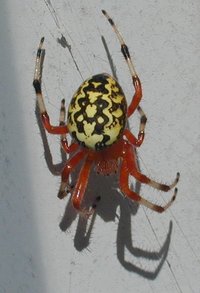Orb-weaver spider
|
|
| Orb weaver spider | ||||||||||||
|---|---|---|---|---|---|---|---|---|---|---|---|---|
| Missing image Araneus_quadratus1.jpg Araneus quadratus Araneus quadratus | ||||||||||||
| Scientific classification | ||||||||||||
| ||||||||||||
| Genera | ||||||||||||
|
Araneus |
The orb-weaver spiders (family Araneidae) are the familiar builders of spiral wheel-shaped webs often found in gardens, fields and forests. The family is a large one, including over 2800 species in over 160 genera worldwide, making it the third largest known (behind Salticidae and Linyphiidae).
Generally, orb-weaving spiders are three-clawed builders of flat webs with sticky spiral capture silk. The web has always been thought of as an engineering marvel. It is built by the spider starting with a line floated on the wind to another surface. The spider secures the line and then drops another line from the center, making a "Y". The rest of the scaffolding follows with the radii of non-sticky silk being constructed before the final spiral of sticky capture silk. The third claw is used to walk on the non-sticky part of the web. Characteristically the prey insect that blunders into the sticky lines is stunned by a quick bite and then wrapped in silk. If the prey is a venomous insect, such as a wasp, wrapping may precede biting.
Some "orb-weavers" do not build webs at all. Members of the genus Mastophora in the Americas and Dicrostichus in Australia produce sticky globules, which contain a pheromone analog. The globule is hung from a silken thread dangled by the spider from its front legs. The pheromone analog attracts male moths of only a few species. These get stuck on the globule and are reeled in to be eaten. Interestingly, both types of "bolas" spiders are highly camouflaged and difficult to locate.
The spiny orb-weaving spiders in the genus Gasteracantha and Micrathena look like plant seeds or thorns hanging in their orb-webs. Some species of Gasteracantha have very long horn-like spines protruding from their abdomens.
One feature of the webs of some orb-weavers is the stabilimentum, a crisscross band of silk through the center of the web. It is found in a number of genera, but Argiope, which includes the common garden spider of Europe as well as the yellow and banded garden spiders of North America, is a prime example. The band has been hypothesized to be a lure for prey, a marker to warn birds away from the web and a camouflage for the spider when it sits in the center of the web.
Most araneid webs are vertical and the spiders usually hang with their "head' downward. A few webs, such as those of orb-weaver in the genus Metepiera have the orb hidden within a tangle space web. Some Metepiera are semi-social and live in communal webs. In Mexico such communal webs have been cut out of trees or bushes and used for living fly paper!
References
- The Life of the Spider by John Crompton. Mentor, 1950.
- How to Know the Spiders by B. J. Kaston. Dubuque, 1953.
- Spiders by Barbara York Main. Sidney, 1976.
- Biology of Spiders, by Rainer F. Foelix, second edition, 1996
External links
- Spiders of Australia (http://www.xs4all.nl/~ednieuw/australian/Spidaus.html)
- Spiders of NW-Europe (http://www.xs4all.nl/~ednieuw/Spiders/spidhome.htm)
- Arachnology Home Pages: Araneae (http://www.arachnology.org/Arachnology/Pages/Araneae.html)
- World Spider Catalog (http://research.amnh.org/entomology/spiders/catalog/)
de:Echte Radnetzspinnen ja:コガネグモ科 lt:Kryžiuočiai zh:圓蛛科
Categories: Spiders | Arachnida | Araneae | Araneomorphae | Araneidae

